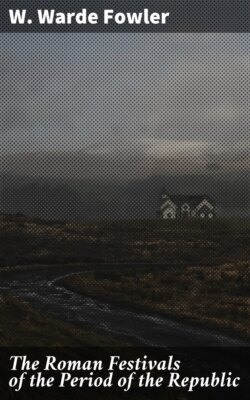Читать книгу The Roman Festivals of the Period of the Republic - W. Warde Fowler - Страница 31
На сайте Литреса книга снята с продажи.
ОглавлениеVesta dabit: Vestae munere purus eris.
Ovid had himself taken part in the rite; had fetched the suffimen, and leaped three times through the flames, his hands sprinkled with dew from a laurel branch. Whether the februa were considered to have individually any special significance or power, it is hard to say. Mannhardt, who believed the ‘October horse’ to be a corn-demon, thought that the burning of its blood symbolized the renewal of its life in the spring, while the ashes thrown into the fire signified the safe passage of the growing crops through the heat of the summer[280]; but about this so judicious a writer is naturally not disposed to dogmatize. We can, however, be pretty sure that the purification was supposed to carry with it protection from evil influences both for man and beast, and also to aid the growth of vegetation. The theory of Mannhardt, adopted by Mr. Frazer, that the whole class of ceremonies to which the Parilia clearly belongs, i.e. the Easter and Midsummer fires and Need-fires of central and northern Europe, may best be explained as charms to procure sunshine,[281] has much to be said for it, but does not seem to find any special support in the Roman rite.
It may be noted in conclusion that a custom of the same kind, and one perhaps connected with a cult of the sun,[282] took place not far from Rome, at Mount Soracte; at what time of year we do not know. On this hill there was a worship of Apollo Soranus,[283] a local deity, to which was attached a kind of guild of worshippers called Hirpi Sorani, or wolves of Soranus;[284] and of these we may guess, from the legend told of their origin, that in order to avert pestilence, &c., they dressed or behaved themselves like wolves.[285] Also on a particular day, perhaps the summer solstice, these Hirpi ran through the flames, ‘super ambustam ligni struem ambulantes non aduruntur,’[286] and on this account were excused by a senatus consultum from all military or other service. A striking parallel with this last feature is quoted by Mannhardt, from Mysore, where the Harawara are degraded Brahmins who act as priests in harvest-time, and make a living by running through the flames unhurt with naked soles: but in this case there seems to be no animal representation. Mannhardt tries to explain the Hirpi as dramatic representations of the Corn-wolf or vegetation spirit.[287] On the other hand, it is possible to consider them as survivals of an original clan who worshipped the wolf as a totem[288]; a view adopted by Mr. Lang[289], who compares the bear-maidens of Artemis at Brauron in Attica. But the last word has yet to be said about these obscure animalistic rites.
